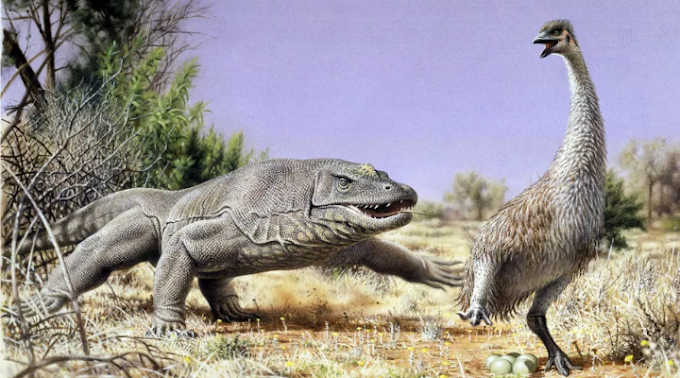Demon geese of doom' laid melon-length eggs in prehistoric Australia
Even demon geese had predators. Here, the large "demon duck of doom" (Genyornis newtoni) flees its nest, pursued through the extinct lizard Megalania (Varanus priscus). Both species lived in Australia approximately 50,000 years ago. (Image credit: Peter Trusler)
Scientists have eventually cracked a 41-year-antique thriller approximately an ancient eggshell from a big, extinct terrestrial fowl with a demonic nickname.
In 1981, researchers in Australia found the charred remnants of severa eggs from numerous cooking fires utilized by prehistoric humans, courting to approximately 50,000 years ago. Some of the eggs have been diagnosed as the ones of emus. But some outsized specimens belonged to a second, unknown chook. For years, scientists argued approximately the identification of that big fowl. But given the eggs' length and age, over time, two contenders emerged: Progura, a collection of big turkey-like birds, or Genyornis, every so often mentioned as "demon geese of doom" due to their big length and evolutionary relation to the smaller waterfowl.
Now, a brand new evaluation the use of state-of-the-art protein sequencing era and synthetic intelligence has placed the talk to rest. The effects, which have been posted May 24 withinside the Proceedings of the National Academy of Sciences, firmly set up the eggs' identification as Genyornis newtoni, Australia's final "thunder chook."
Genyornis newtoni became an intimidating creature. It stood over 6.five feet (2 meters) tall and tipped the scales at as much as 530 pounds (240 kilograms) of beak, bones and feather-clad muscle, in line with the Australian Museum. "I can believe that having this mega duck searching down at one have to be pretty unnerving!" lead look at writer Beatrice Demarchi, an archaeologist reading bones and different natural substances on the University of Turin in Italy, informed Live Science in an email.
Fittingly, those mega geese additionally laid big eggs; every weighed round 3.five pounds (1.6 kg), approximately the dimensions of a melon. Genyornis' big eggs might had been a super supply of protein for Indigenous Australian humans, supplied they may correctly accumulate them from the huge birds' nests. In fact, the scientists now suspect that humans' urge for food for the melon-length eggs may also have helped drive Genyornis to extinction, in line with The Natural History Museum, London.
While bits of fossilized egg won't be as flashy as a fossilized skull, "small and mundane matters together with eggshells can display lots approximately what the surroundings seemed like," stated Demarchi. Curiosity approximately that historic surroundings drove researchers to re-look at shell fragments that have been found withinside the Nineteen Eighties at Australian sites , the use of a specific technique: protein sequencing.
When scientists are looking to pick out a selected species, DNA sequencing is typically desired over protein sequencing. Proteins do not mutate as fast or as randomly as DNA does, this means that that their genetic signatures are extra difficult to detect. "However, they ultimate approximately 10 instances longer than DNA," this means that that there is probably sufficient proteins preserved in older cloth wherein plenty of the DNA has eroded over time, Demarchi stated. Given the age and the burial temperature of the eggshell fragments (which have been cooked over an open flame), maximum of the DNA withinside the egg samples became too degraded to be useful. The proteins, however, have been nevertheless in quite right shape.
—These large birds should eviscerate you. People have been elevating them 18,000 years ago.
—Ancient Egyptians May Have Corralled Millions of Wild Birds to Sacrifice and Turn into Mummies
—10 of the largest birds on E uparth
After sequencing those molecules and figuring out which genes might have produced them, the researchers used a unique set of rules to evaluate their findings to the genomes of extra than 350 dwelling species of birds. The effects found out that the eggs have been now no longer laid through a collection of huge-footed chicken-like birds referred to as megapodes, and consequently did now no longer belong to the Progura genus, look at co-writer Josefin Stiller, an evolutionary biologist on the University of Copenhagen in Denmark, stated in a statement.
Research including this gives precious insights into humans' effect at the herbal world, displaying that wherein our ancestors lived and what they ate may also have contributed to the extinction of sure species. Although the so-referred to as demon geese are not round, the classes from our beyond interactions with them keep to resonate. Demarchi and her colleagues wish to hold their work "searching at different huge birds from the beyond and running out their relationships with humans at special factors in time," Demarchi stated.













